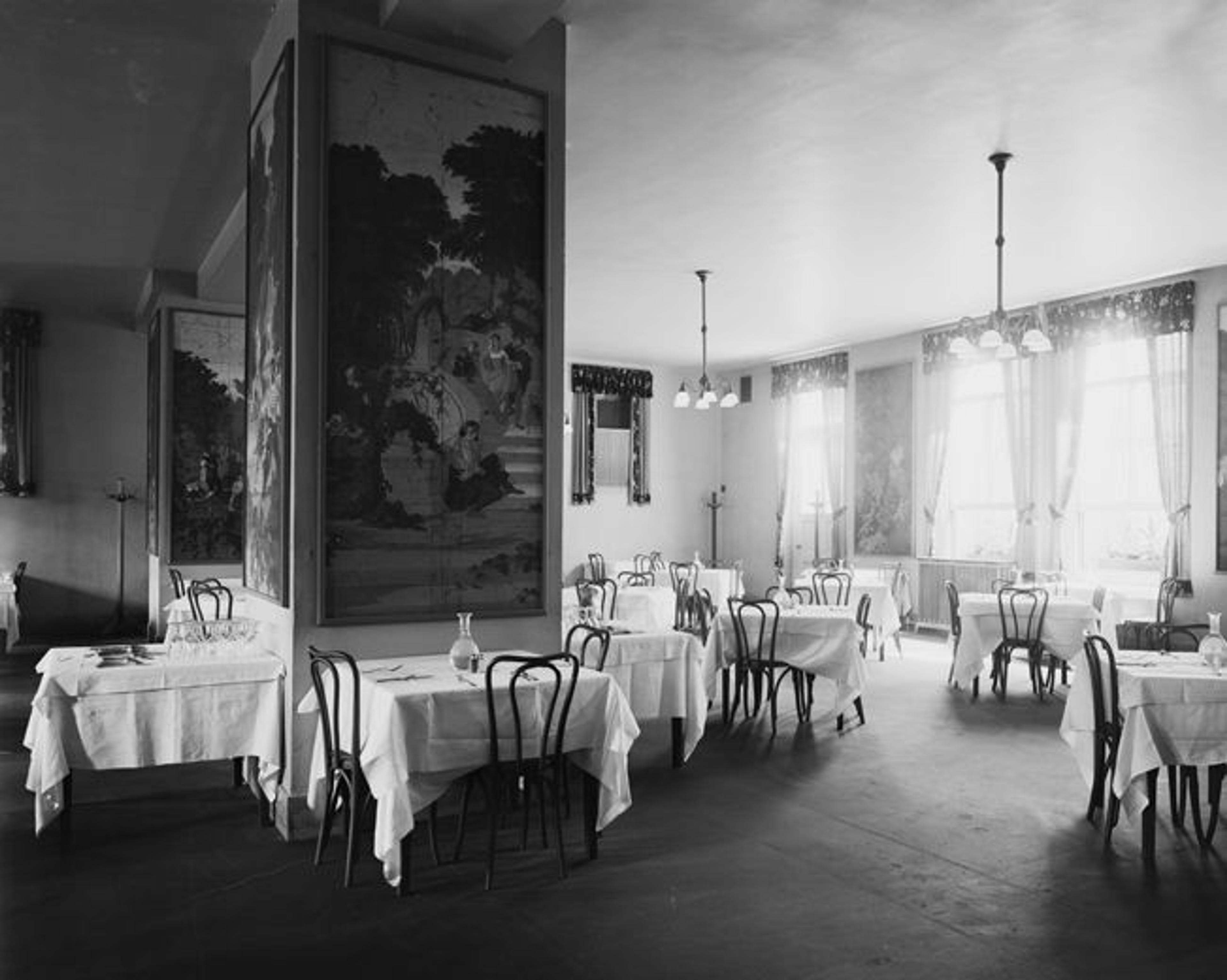
The Metropolitan Museum of Art, Restaurant; View facing northwest. Photographed September 11, 1918. See slideshow
«The Museum's first Bulletin, published in November 1905, mentions a restaurant "located in the basement of the North side of the Main building. Meals are served à la carte, from 10 a.m.–6 p.m., and table d'hote from 12 a.m.–6.pm." (The Metropolitan Museum of Art Bulletin, Vol. 1, No. 1, Nov. 1905). The Museum Restaurant was located near the western end of what was then known as the Hall of Casts, accessible via a staircase leading to the basement (approximately where the current Public Cafeteria is now). By 1912 an entire renovation was planned for the restaurant, as "[it] has never been an attractive place to visitors, partly because of its location . . . but equally because of its dark, cheerless aspect, [and was] so far removed from the toilet rooms . . . [that it was] a serious drawback." (The Metropolitan Museum of Art Bulletin, Vol. 7, No. 10, Oct. 1912). Accordingly, these planned renovations highlighted "a rest-room for women, with a toilet-room attached, [including] wash-basins with hot and cold water, while a smoking room will be provided for men, also with lavatories" (ibid.).»
In 1917, the Museum decided to renovate again "since good digestion depends upon pleasant environment" (The Metropolitan Museum of Art Bulletin, Vol. 13, No. 10, Oct. 1918). Architectural changes were impossible due to World War I, but "decided improvement [was] effected through the use of paint, chintz, and the exhibition of some original works of art" (ibid.). Among these works of art were panels of French nineteenth-century scenic wallpaper, a few pieces of early nineteenth-century furniture, two sculptures, an ornamental vase, and a marble statue of Cupid by John Gibson. The color scheme was sea-green with chintz of brightly colored flowers on a dark background; the plaster was kept a light cream color. The tables and chairs were painted a "harmonious shade of green, which [was also seen in] the light fixtures with their bell-shaped shades of glass decorated with a grape vine pattern" (ibid.). Also because of the war, service in the restaurant was limited to an à la carte luncheon and afternoon tea, with no dinner service available.
The Museum Restaurant shifted to a self-service cafeteria beginning in 1922 (The Metropolitan Museum of Art Bulletin, Vol. 17, No. 10, Oct. 1922), in the hopes that "visitors . . . students and copyists . . . and the employees . . . may find a comfortable, attractive, and economical place in which to lunch or have tea. . . . A separate room nearby is being fitted up for the use of classes from schools who bring their own lunches and need a comfortable place in which to eat them" (ibid.).
In 1923, the Museum opened a courtyard café adjacent to the cafeteria, located "in the basement on the north side of the main building," which was used "for luncheon or for light refreshments during the afternoon." (The Metropolitan Museum of Art Bulletin, Vol. 18, No. 8, Aug. 1923). The statue prominently displayed in the café (seen in image four in the accompanying slideshow), Dancing Girl by Ludwig Michael von Schwanthaler, is not currently on view. There is photography of the café as late as 1928, but no mention as to whether it was open year-round.
For the next twenty years, the Museum Restaurant operated without much notable change. However, an announcement was made in 1941 that the space would be closed in July for alterations, and upon re-opening would have facilities "for both table- and self-service" (The Metropolitan Museum of Art Bulletin, Vol. 36, No. 8, Aug. 1941). The Museum's goal when renovating this time was to provide visitors with "an inviting and cheerful little reception room, apple green and various shades of coral and lemon yellow . . . throughout the entire restaurant, [including] the leather upholstery of the Chippendale chairs. . . . The ceilings are acoustically treated to enhance the enjoyment of recorded music, which is played intermittently for luncheon and afternoon tea, from 11 o'clock until 4:45 every week day. . . . An attractively furnished section at the north end is reserved for more formal service. This small room . . . is separated from the main room by pilasters, a lintel, and low boxes of plants" (The Metropolitan Museum of Art Bulletin, Vol. 36, No. 10, Oct. 1941).
In the late 1940s, the Museum announced a completely new restaurant, to be housed in the in the Lamont Wing's Roman courtyard, which would be completed in late 1953. The restaurant was designed by Dorothy Draper Inc., and "[a] pool was decided on as the centerpiece of the restaurant that would replace the old Pompeian court" (The Metropolitan Museum of Art Bulletin, New Series, Vol. 53, No. 1, Summer 1995). At the center of the pool was a work commissioned by the Museum from the Swedish-born sculptor Carl Milles, titled The Fountain of the Muses, which now resides with Brookgreen Gardens—a sculpture garden and wildlife preserve located in Murrells Inlet, South Carolina.